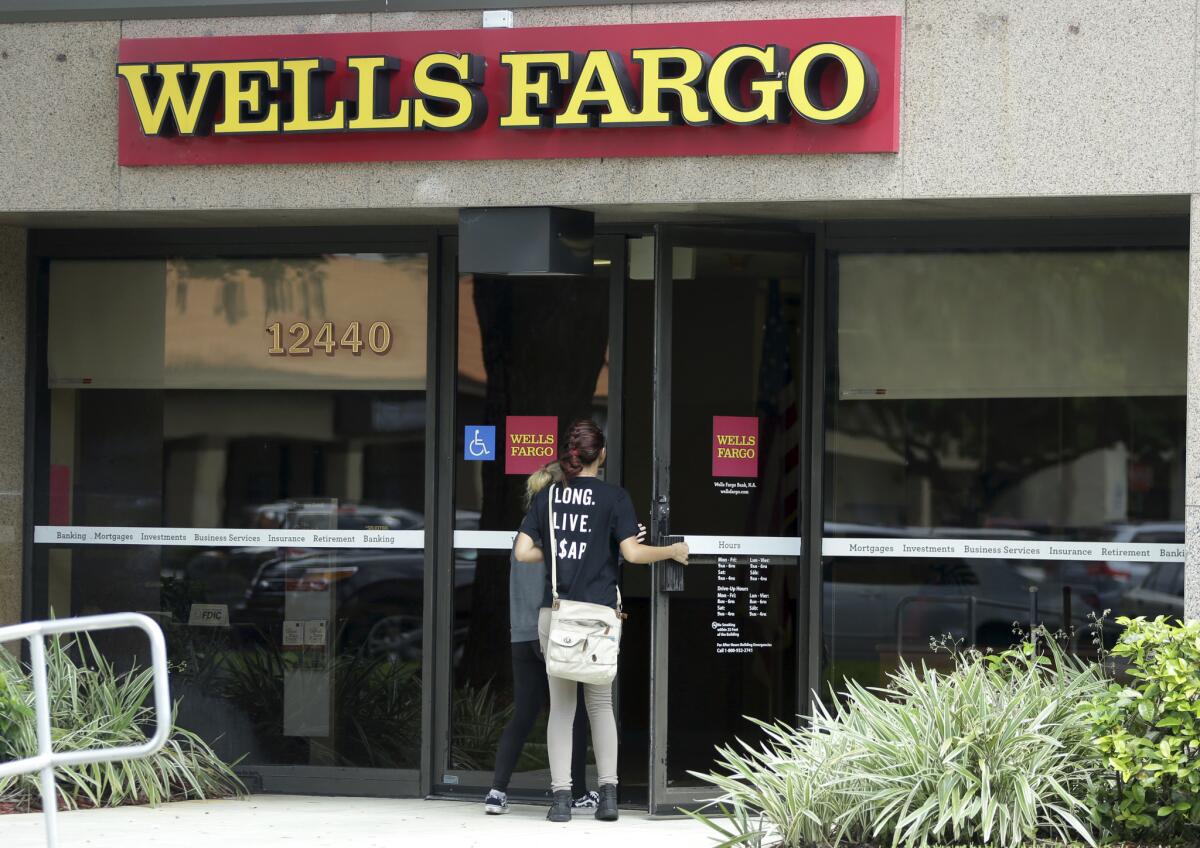Wells Fargo overhauls pay plan for branch employees following fake-accounts scandal

- Share via
Wells Fargo & Co. will change how it pays tellers and other bank workers, announcing on Tuesday a long-anticipated overhaul of the incentive-compensation system that was at the root of the bank’s fake-accounts scandal.
The bank for years used sales goals to push workers to open more accounts — checking, savings, credit cards — for customers. Trying to meet those goals, thousands of workers over the last several years opened as many as 2 million accounts without customers’ knowledge or approval, according to local and federal regulators, who fined the bank $185 million last year over those practices.
The San Francisco banking giant said the new incentive system will no longer reward employees simply for opening accounts but will instead judge them on how often customers use their accounts and whether customers are satisfied with the bank’s services.
Wells Fargo executives have been working on the plan since soon after the settlements with federal regulators and the Los Angeles city attorney’s office were announced in September. The updated plan has been considered a high priority for Chief Executive Tim Sloan and Mary Mack, the head of Wells Fargo’s community bank division — both of whom took those jobs after the scandal emerged.
“Do [customers] use the products they have with us? Do they think of us as their primary bank? Are we growing customers who consider us their primary bank? These are the metrics we are now measuring,” Mack said.
Accounts that are used frequently, such as those for which customers set up direct deposits or use debit cards often, will be a positive factor for an employee’s pay. Idle accounts will not, and an account won’t be a factor toward incentives until it has been open three months.
“Our goal here was to create a pay plan that would restore trust with our customers, team members and the public,” Mack said.
In the months since the scandal broke, the bank has reported lower customer-satisfaction scores and a sharp drop in the number of new account openings. In November, Wells Fargo opened about 300,000 checking accounts, down from 500,000 accounts opened in November 2015 — evidence that the bank has a long way to go to rebuild its reputation with existing and would-be customers.
By giving workers credit only for accounts that are active and still in use after several months, executives probably hope to prevent employees from opening unauthorized accounts to game the incentive system.
Regulators found that workers not only created accounts without customers’ knowledge, but sometimes forged signatures, created fake customer email addresses and even moved money from existing accounts into new, unauthorized ones, all in an attempt to show that they were opening enough new accounts to meet onerous sales goals.
Though the new incentive system is a big change for Wells Fargo, it is similar to incentive systems at other banks, including JPMorgan Chase and Bank of America, which already give employees credit only for actively used accounts.
Under the old Wells Fargo system, workers could get credit for opening a savings account once a minimum deposit of $25 was made, even if that money came from another Wells Fargo account and even if the account sat unused afterward. At Chase, workers get credit for opening a savings account only if the customer deposits at least $1,000 within two months — and that money can’t come from another Chase account.
At both Chase and Bank of America, workers get credit for opening a credit card account only after the account has been used. At Wells Fargo, workers got credit once a card was issued, a system that former employees said encouraged some bankers to apply for credits cards on customers’ behalf without authorization.
Along with account usage, Wells Fargo workers will be scored based on customer service surveys done by Gallup and by mystery shoppers who visit bank branches.
As part of the new incentive system, workers will also get more base pay and less incentive and bonus pay. For tellers, about 95% of pay will be base pay. The bank said last week that it would boost the pay for its lowest-level workers to between $13.50 and $17 per hour, depending on geography and experience.
Wells Fargo executives have explained the new incentive system to regional executives and district managers and, over the next few weeks, will provide details of the plan to branch managers and workers, bank spokeswoman Mary Eshet said.
The bank provided a two-page summary of the plan to the Los Angeles Times and other media outlets Tuesday, but corporate compensation plans can be hundreds of pages long.
Margaret Kane, founder of bank sales consulting firm Kane Bank Services, said the plan seems to address the biggest problems unearthed by the accounts scandal — largely by eliminating incentives for opening accounts that aren’t used. Still, she said it’s not clear how Wells Fargo will set goals for branches and employees.
“How are they going to define a job well done? That’s what we don’t know,” she said. “What they’re doing is totally the way they should be going, but the devil is in the details.”
For instance, because the new plan has a greater focus on customer service surveys, Kane said it might push workers to pressure customers into giving good reviews.
“That has happened in other industries — you see it in hospitality,” she said. “I think customer service is one that they’ll want to keep an eye on.”
Mack acknowledged that Wells Fargo still has work to do to restore its image, saying the new compensation plan is “an answer, not the answer.”
“This is just one step to restore trust,” she said.
As it works to restore trust with consumers, the bank remains under investigation by a handful of state and federal agencies, including the California Department of Justice, the U.S. Department of Labor and the Securities and Exchange Commission. It’s a list that has steadily grown over the last few months.
In December, state insurance regulators in California and New Jersey said they would probe the bank’s sales practices after former employees of insurer Prudential filed a lawsuit claiming that Wells Fargo workers pushed Prudential policies on customers who did not want them.
Wells Fargo is set to report its quarterly results Friday, when it is expected to give more details about the compensation plan.
The Associated Press contributed to this report.
Follow me: @jrkoren
ALSO
Snapchat in 2017: 7 predictions about what’s next
Trump’s tweets are a new challenge for automakers
Meet the Hollywood producer at the center of a scandal shaking the Israeli government
UPDATES:
4:55 p.m.: This article was updated with more details on Wells Fargo’s fake-accounts scandal and its impact on new account openings, as well as information on investigations into the bank’s practices.
3:45 p.m.: This article was updated with Times reporting, including details about other banks’ compensation practices and comments from bank consultant Mary Kane.
1:30 p.m.: This article was updated throughout with additional details, comments and background information.
This article was originally published at 1:20 p.m.
More to Read
Inside the business of entertainment
The Wide Shot brings you news, analysis and insights on everything from streaming wars to production — and what it all means for the future.
You may occasionally receive promotional content from the Los Angeles Times.











